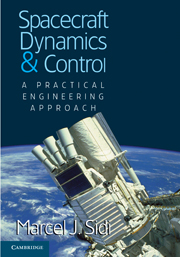Book contents
- Frontmatter
- Dedication
- Contents
- Preface
- Acknowledgments
- Chapter 1 Introduction
- Chapter 2 Orbit Dynamics
- Chapter 3 Orbital Maneuvers
- Chapter 4 Attitude Dynamics and Kinematics
- Chapter 5 Gravity Gradient Stabilization
- Chapter 6 Single- and Dual-Spin Stabilization
- Chapter 7 Attitude Maneuvers in Space
- Chapter 8 Momentum-Biased Attitude Stabilization
- Chapter 9 Reaction Thruster Attitude Control
- Chapter 10 Structural Dynamics and Liquid Sloshing
- Appendix A Attitude Transformations in Space
- Appendix B Attitude Determination Hardware
- Appendix C Orbit and Attitude Control Hardware
- Index
- References
Appendix C - Orbit and Attitude Control Hardware
Published online by Cambridge University Press: 18 December 2014
- Frontmatter
- Dedication
- Contents
- Preface
- Acknowledgments
- Chapter 1 Introduction
- Chapter 2 Orbit Dynamics
- Chapter 3 Orbital Maneuvers
- Chapter 4 Attitude Dynamics and Kinematics
- Chapter 5 Gravity Gradient Stabilization
- Chapter 6 Single- and Dual-Spin Stabilization
- Chapter 7 Attitude Maneuvers in Space
- Chapter 8 Momentum-Biased Attitude Stabilization
- Chapter 9 Reaction Thruster Attitude Control
- Chapter 10 Structural Dynamics and Liquid Sloshing
- Appendix A Attitude Transformations in Space
- Appendix B Attitude Determination Hardware
- Appendix C Orbit and Attitude Control Hardware
- Index
- References
Summary
Introduction
The purpose of Appendix C is to introduce the reader to the basic features of the control hardware used to provide translational and angular accelerations to spacecraft.
The level of control forces that can be obtained depends on the source characteristics. For example, ion thrusters can produce forces of the order of tens of milli-newtons; liquid propellant thrusters used in spacecraft control provide forces in the range of hundreds of newtons; and solid propellant motor-produced forces are in the range of hundreds of thousands of newtons.
As far as attitude control is concerned, we have seen that torques can be produced with the aid of momentum exchange devices, magnetic torqrods, or solar torque controllers. The torque levels we can obtain with these devices are generally low: in the range of 0.01 to 1 N-m for momentum exchange devices (control moment gyros excluded), of the order of a few centinewton-meters with magnetic torqrods, and tens of micronewton-meters with solar torque controllers. With reaction propulsion means we can achieve torques of about 20–30 N-m, but also much lower torques of the order of 0.1 N-m if needed. Reaction propulsion is also used for momentum dumping – unloading the parasitic angular momentum accumulated in the spacecraft.
The sources of force and torques used for control can be classified as follows:
propulsion systems, which can provide translatory and angular accelerations (forces and torques) to the satellite;
solar radiation pressure, which can produce forces and torques;
momentum exchange devices, which can provide torques and angular momentum; and
magnetic torqrods, which can provide only torques.
Two special controllers that are not discussed in this book are (i) atomic energy-based thrusters for translation accelerations, and (ii) control moment gyros, which are used in large inhabited space structures to provide torques in the range of hundreds of newton-meters.
- Type
- Chapter
- Information
- Spacecraft Dynamics and ControlA Practical Engineering Approach, pp. 379 - 402Publisher: Cambridge University PressPrint publication year: 1997
References
- 1
- Cited by



